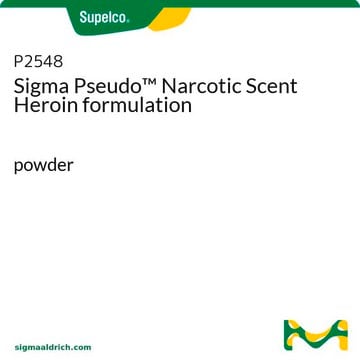P-007
PCP (Phencyclidine) solution
1.0 mg/mL in methanol, ampule of 1 mL, certified reference material, Cerilliant®
Sinónimos:
Phencyclidine
About This Item
Productos recomendados
grado
certified reference material
formulario
liquid
Características
Snap-N-Spike®/Snap-N-Shoot®
envase
ampule of 1 mL
fabricante / nombre comercial
Cerilliant®
drug control
Narcotic Licence Schedule A (Switzerland); psicótropo (Spain); Decreto Lei 15/93: Tabela IIA (Portugal)
concentración
1.0 mg/mL in methanol
técnicas
gas chromatography (GC): suitable
liquid chromatography (LC): suitable
aplicaciones
forensics and toxicology
formato
single component solution
temp. de almacenamiento
2-8°C
InChI
1S/C17H25N/c1-4-10-16(11-5-1)17(12-6-2-7-13-17)18-14-8-3-9-15-18/h1,4-5,10-11H,2-3,6-9,12-15H2
Clave InChI
JTJMJGYZQZDUJJ-UHFFFAOYSA-N
Descripción general
Aplicación
- A Collaborative Platform for Novel Compound Identification - Characterization of Designer Phencyclidines (PCPs) POXP, PTHP, and P2AP: This research highlights a collaborative platform for the identification and characterization of novel designer PCPs, emphasizing their potential as analytical standards and sigma receptor agonists. The study provides valuable insights for scientists involved in receptor binding studies and the development of dissociative anesthetics for research (Sisco, Urbas, 2023).
- Long-term adaptation of prefrontal circuits in a mouse model of NMDAR hypofunction: Investigating the long-term effects of NMDAR hypofunction in mice, this study uses PCP to elucidate mechanisms of schizophrenia, showcasing its application as a NMDA receptor antagonist in neuropharmacological studies. The findings are crucial for advancing knowledge on neurotransmitter research and mental health disorders (Ponserre et al., 2024).
- 3-Methoxy-Phencyclidine Induced Psychotic Disorder: A Literature Review and an (18)F-FDG PET/CT Case Report: This review and case report discuss the psychiatric implications of 3-Methoxy-Phencyclidine, a derivative of PCP, providing insights into its effects on human cognition and behavior. Such studies are essential for developing high-purity PCP liquids for sigma receptor assays and understanding its role as a non-competitive NMDA antagonist (Pepe et al., 2024).
- Trips Through the Skin: Reviewing Cutaneous Drug Reactions to Psychedelics and Hallucinogens: This review explores the dermatological reactions associated with psychedelic drugs, including PCP. It underscores the importance of understanding the biochemical pathways affected by PCP, reinforcing its utility as a research chemical in pharmaceutical applications (Rahman et al., 2024).
- Novel α-amino-3-hydroxy-5-methyl-4-isoxazole-propionic acid receptor (AMPAR) potentiator LT-102: A promising therapeutic agent for treating cognitive impairment associated with schizophrenia: This research explores the potential therapeutic uses of AMPAR potentiators, highlighting PCP′s role in enhancing understanding of glutamatergic dysfunction in schizophrenia. It showcases PCP′s utility in developing treatments that modulate neurotransmitter systems, valuable for neuropharmacology research (Qi et al., 2024).
Información legal
Producto relacionado
Palabra de señalización
Danger
Frases de peligro
Consejos de prudencia
Clasificaciones de peligro
Acute Tox. 3 Dermal - Acute Tox. 3 Inhalation - Acute Tox. 3 Oral - Flam. Liq. 2 - STOT SE 1
Órganos de actuación
Eyes,Central nervous system
Código de clase de almacenamiento
3 - Flammable liquids
Clase de riesgo para el agua (WGK)
WGK 2
Punto de inflamabilidad (°F)
49.5 °F - closed cup
Punto de inflamabilidad (°C)
9.7 °C - closed cup
Certificados de análisis (COA)
Busque Certificados de análisis (COA) introduciendo el número de lote del producto. Los números de lote se encuentran en la etiqueta del producto después de las palabras «Lot» o «Batch»
¿Ya tiene este producto?
Encuentre la documentación para los productos que ha comprado recientemente en la Biblioteca de documentos.
Los clientes también vieron
Nuestro equipo de científicos tiene experiencia en todas las áreas de investigación: Ciencias de la vida, Ciencia de los materiales, Síntesis química, Cromatografía, Analítica y muchas otras.
Póngase en contacto con el Servicio técnico
















